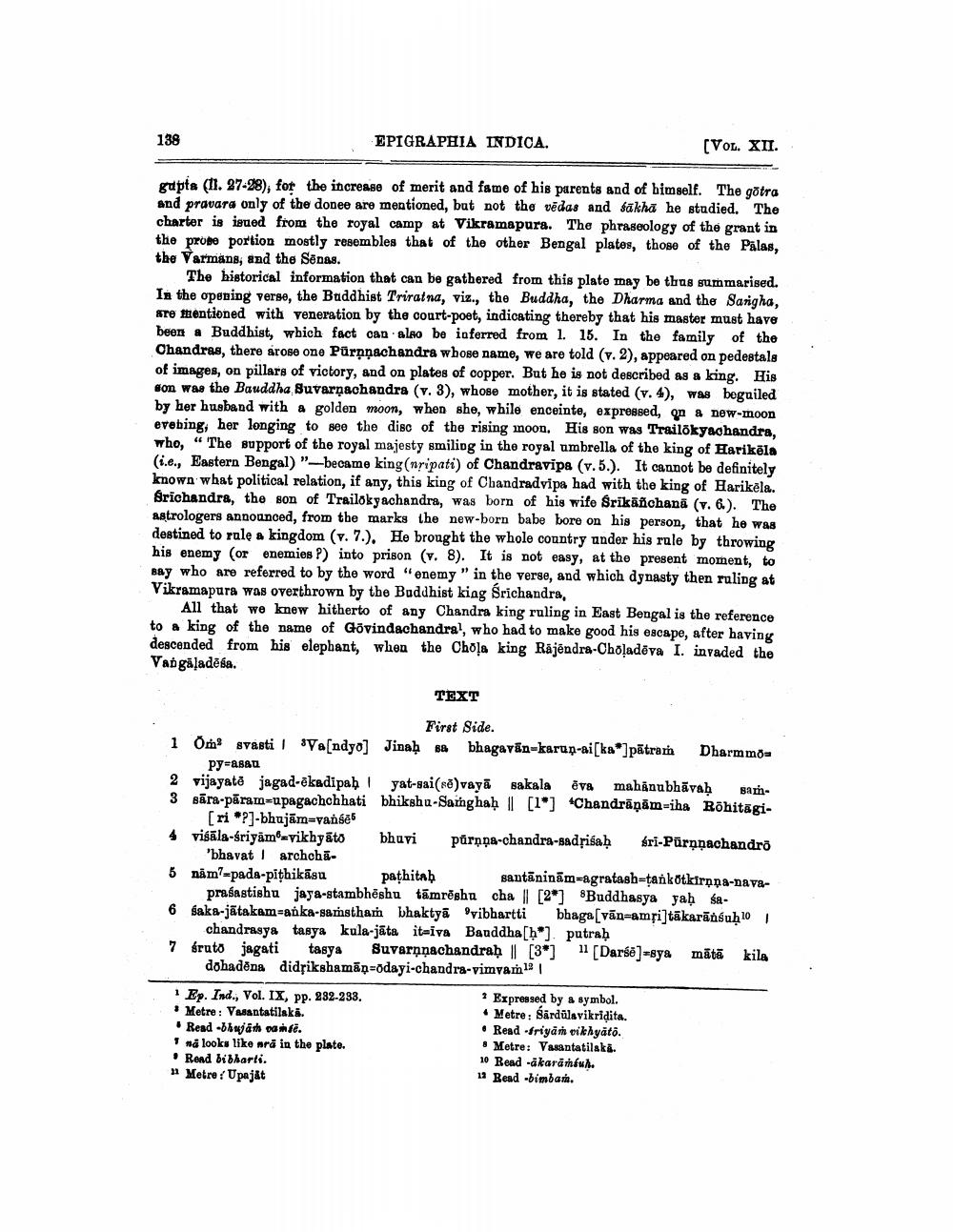________________
138
EPIGRAPHIA INDICA.
(VOL. XII.
gapts (II. 27-28), for the increase of merit and fame of his parents and of himself. The gotra and pravara only of the donee are mentioned, but not the vēdas and sakha he studied. The charter is igued from the royal camp at Vikramapura. The phraseology of the grant in the probe portion mostly resembles that of the other Bengal plates, those of the Palas, the Yarmans, and the Sēnas.
The historical information that can be gathered from this plate may be thus summarised. Is the opening verse, the Buddhist Triratna, viz., the Buddha, the Dharma and the Sarigha, sre mentioned with veneration by the court-poet, indicating thereby that his master must have been a Buddhist, which fact can also be inferred from 1. 15. In the family of the Chandras, there arose one Purņņachandra whose name, we are told (v.2), appeared on pedestals of images, on pillars of victory, and on plates of copper. But he is not described as a king. His son was the Bauddha Suvarnachandra (v. 3), whose mother, it is stated (v.4), was beguiled by her husband with a golden moon, when she, while enceinte, expressed, on & new-moon erebing, her longing to see the disc of the rising moon. His son was Trailökyachandra, who, “The support of the royal majesty smiling in the royal umbrella of the king of Harikēla (i.e., Eastern Bengal) "-became king (nripati) of Chandravipa (v.5.). It cannot be definitely known what political relation, if any, this king of Chandradvipa had with the king of Harikela. Srichandra, the son of Trailokyachandra, was born of his wife Srikāñchanā (v. 6). The astrologers announced, from the marks the new-born babe bore on his person, that he was destined to rule a kingdom (v. 7.). He brought the whole country under his rule by throwing his enemy (or enemies ?) into prison (v. 8). It is not easy, at the present moment, to Bay who are referred to by the word "enemy" in the verse, and which dynasty then ruling at Vikramapura was overthrown by the Buddhist king Srichandra,
All that we know hitherto of any Chandra king ruling in East Bengal is the reference to a king of the name of Govindachandra!, who had to make good his escape, after having descended from his elephant, when the Chola king Rājēndra-Choladēva I. invaded the Vangaladesa.
TEXT
First Side. 1 Om svasti 'Yandyo] Jinaḥ sa bhagavin-karup-ai[ka]pātram Dharmmon
py=26&u 2 vijayatě jagad- kadipah! yat-sai(rē)vayā sakala ēva mahānubhāvah sam3 sāra-pāram=upagachchhati bhikshu-Samghaḥ || [l*] "Chandrāņām=iha Bohitagi
[ri?]-bhujām=yanseb 4 visila-sriyām®-vikhyāto bhuvi pārņna-chandra-sadrisaḥ sri-Purnnachandro
'bhavat archcha5 năm?spada-pitbikāsu pathita) santāninām-agratasb-tankotkirppa-nava
praśastishu jaya-stambhēshu tāmrēshu cha || [2] Buddhasya yaḥ śa6 saka-jātakam-anka-samstham bhaktyā øvibhartti bhaga(vān=amți]tākarāńśuḥ101
chandrasya tasya kula-jāta it-iva Bauddha[h*) putrah 7 bruto jagati tasya Suvarnnachandraḥ || [38] 11 [Darsē] sya mātā kila
dohadēna didrikshamāņ=odayi-chandra-vimvam12
1 Ep. Ind., Vol. IX, pp. 232-233. • Metre : Vasantatilaka.
Read -bhujah naise.
na looks like ara in the plate. • Rend bibharti.
Metre Upajat
* Expressed by a symbol. • Metre: Sārdūlavikridita. • Read .friyan ikhyato. • Metre: Vasantatilaki. 10 Read -akaranina. 13 Bead -bimbani.




